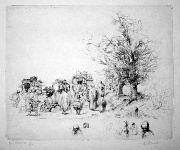The glory and decline of original etching
The 1920s mark the apex of his career : young and energetic dealers like Marcel Guiot, Henri Petiet et Etienne Bignou act to promote his work. They commission and sell his original etchings. He is also called upon for book illustration, as was the fashion of the time. Simultaneously his repute - and also his financial position - definitely benefit from the rage for etching which swells in the United States after WW I, so that many of his etchings are still to be found in the USA.
This dynamics comes to a sudden halt with the 1929 crash. In 1932, the Chalcographie du Louvre buys a set of plates from him, maybe as a financial help. A few illustrated books are still published (but the planned Crainquebille will never appear), new plates become scarce. Brouet dies during WW II, in 1941, in difficult financial circumstances. After WW II, etching never quite recovered to the heights of the Années folles, while figurative artists fall out favor, and the work of Auguste Brouet with them.
- Lucien Descaves, Souvenirs d'un Ours, Editions de Paris, 1946.
